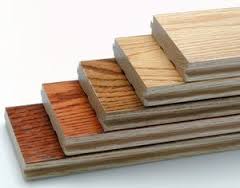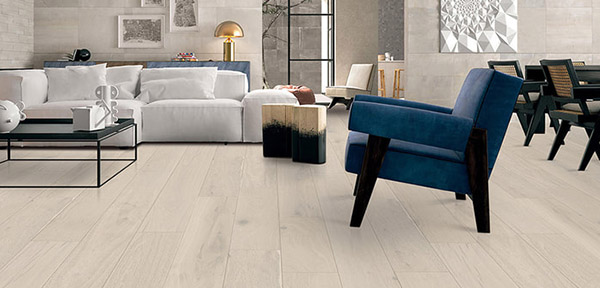Featured In


Ready to get started?
Schedule your Free In-home estimate
Flooring for Business
Full-Service Commercial Flooring Solutions
We serve businesses of all sizes from corporate and healthcare facilities, to small businesses, and property management groups.
Contact UsEngineered Wood Flooring

Engineered flooring is Engineered wood where only the first layer is solid wood and the rest is a criss cross plywood. It is used for all grades above and below, concrete slab or ply-wood. This makes a perfect floor because its very stable.
The criss cross layers below the solid piece of wood acts as a stable foundation, making it very stable against moisture and elevated levels of humidity. It acts as a 3:1 moisture barrier between your concrete and hardwood.
Most engineered flooring have pretty good thick tops you can sand just as much as a solid. You can't sand past the tongue anyway whether it be a solid or engineered. Plus most if not all engineered hardwood finishes are heat treated at the factory, making the finish 4 times stronger that traditional poly-urethane. That's the reason why most engineered flooring come with a 20 - 30 year wear warranty. The heat treated process cannot be duplicated on site.
Solid Wood Flooring

A solid wood pre-finished or un-finished wood is when a piece of wood is solid from top to bottom. This plank gets nailed down on a wooden sub-floor. It cannot be installed in a concrete surface house. No matter what anyone says, a solid is only designed to be nailed on a peer and beam housing. An expansion gap is important because solid wood expands and contracts easily.
Solid wood floors are meant to get nailed down on top of peer and beam homes. Companies install 3/4" inch plywood on top of concrete flooring all the time and nail down the solid hardwood on top of the plywood. This would act as a base so that a solid can be nailed down onto the plywood. Although this method is practiced on top of a concrete flooring, this method is not recommended by us in anyway. Solid wood floors are meant to be nailed on top of pear and beam foundations where the building is constantly breathing and is not dependant upon an A / C unit to keep it ventilated. Any house that has a concrete floor, will always depend on the A / C unit to keep the artificial environment consistent. Once this changes for any reason, this type of floor will cup or buckle. Any home with concrete will need engineered hardwoods. Another good type of floor that performs well is luxury vinyl plank. Get luxury vinyl plank flooring in Austin, TX by us today.
With so many choices how do you know what's best?
Let's admit it you don't want to be embarrassed by making a wrong decision in floor color or floor product.
The main one, the most important one is color. Our professional suggestion is to pick a neutral light color. Why?
In today's market, designers, builders and remodelers are doing this because it allows them and potential buyers to play with wall color and furniture color from light to dark without worrying about floor color interfering with wall or furniture color choices.
What kind of product should I use vinyl plank , wood, or tile?
Tile is good in showers, kitchen backsplashes and bathroom floors. However when it comes to doing a whole house, people report tile to be colder to the touch and a bit harder to clean vs hardwood or vinyl plank. If you're going to choose a hardwood consider this.
Birch, bamboo, and cork are very soft and can scratch and dent easily. Floors like oak, hickory, and Maple although are better since they are harder, these floors still require an aluminum oxide finish to protect them from being dented or scratched hence the traditional high gloss look.
 European oak on the other hand is hard enough to not require an aluminum oxide finish. Often they get an oil finish or a real thin coat of oxide urethane finish for protection. European oak natural color is light so its neutral but also come in darker shades.
European oak on the other hand is hard enough to not require an aluminum oxide finish. Often they get an oil finish or a real thin coat of oxide urethane finish for protection. European oak natural color is light so its neutral but also come in darker shades.
What about solid or engineered hardwood?
If you have a concrete floor do not do solids. Even though solid wood floors may sound like a good idea they are designed to be traditionally nailed on a pier and beem floor. If conditions are not right in a house like not enough air circulation or humidity levels spike, solid floors can cup and buckle even on a second story wood subfloor. On the other hand engineered floors have a crisscross plywood below the thin layer of your real wood to help it stabilize and be water resistant. Engineered wood can be use in kitchens and powder baths.
These floors are designed to get installed in a house with concrete. Furthermore if you have a peer beam house or you want to install hardwoods on a second story floor, gluing engineered wood floors on peer and beam or second story plywood floor is recommended because the engineered floor and glue combination fuses the floor together helping rid of squeaks common on second story or peer and beam floors.
In the past hardwoods especially engineered were often criticized by their thin tops versus their thick top 3/4" solid forefathers. Logic says if you install a soft wood it will eventually dent and scratch so you will need to resand it in the future. Similarly if you install a wood hard enough to withstand wear and tear, it will never require re-sanding. European oak will less likely need sanding because it's rare to dents or scratches. And in case you do dent or scratch one, replacing one plank is much easier than having to resand an entire floor.
What about vinyl plank?


The old vinyl plank floors were thin flimsy glue down planks that required special treatments on subfloor before gluing. Moreover the old vinyl plank floors did not have the depth or look of a real hardwood floor.
Take a look at this vinyl plank floor,. notice how it looks similarly to a hardwood. It's also waterproof, and resistant to dents and scratches. Today vinyl plank floors are just as sturdy and scratch resistant like a European oak. In fact designers, builders, and remodelers alike are starting to do more and more vinyl plank. Vinyl plank floors are water resistant and can be used throughout your whole house including your bathroom floor.

